Imagine sitting by the campfire one chilly night watching the aurora borealis painting a beautiful picture across the sky. Unless you are a dog sled runner, you probably won’t have three dogs with you to help you keep warm.
Backpackers that enjoy Alpine views or early spring, late fall and winter hikes need one of the best insulated jackets. Especially during the winter climate you never know when a snowstorm will sneak up on you. It is kind of like the story, “The Three Bears”. You want your jacket just like Baby Bear would want it: “Not too hot, not too cold, but just right!”
In this article, we are going to look at what goes into an insulated jacket as far as insulation and inner and outer linings are concerned. We will also explore features such as weight, fit, hoods, and pricing.
Fabrics: Living in A Material World
Outer Linings or Shell
The shell of these insulated jackets is typically made of nylon. There are also some specialty fabrics such as Pertex Quantum and Schoeller®. The Pertex Quantum is an extremely soft fabric that allows the insulation to fully loft. It is both lightweight and durable; it is enhanced by its strength. It is also windproof.
The Schoeller® fabrics have no cotton content to save on water to irrigate and the area of cultivation. Also, the fabrics are recyclable in keeping with Schoeller’s green technologies. The NanoSphere technology gives you fabrics that are moisture, dirt, and oil repellent as well as wash and abrasion resistant. This fabric is still very breathable.

The Ripstop nylons come in different strengths that are described in denier, a measurement of the fiber thickness of individual threads which in turn is used to make the fabric.
Insulation: Baby it’s Cold Outside
You will notice as you read the reviews that none of the jackets have down insulation. The technology on polyester insulation has been advancing and today’s insulations are much more sophisticated.
They don’t bunch up; they are compressible, yet keep their loft when needed; they are extremely lightweight. They don’t ride up, but yet they stretch and move with the shell and lining. The insulations are breathable, yet offer excellent protection from cold.
The thickness of insulation is defined as grams per square meter; the higher the number, the thicker and warmer the insulation. As a rule of thumb, jackets in the 50g-100g range are good for cooler spring and fall weather where you can dress in layers. For extreme cold temps, you would need to be in the 100g-200g range. Most of the jackets in today’s review fall into the 50g-100g range.
Inner Lining: Every Cloud Has a Silver Lining
It is typical to see the linings of jackets made of 100% nylon. It can be in a Ripstop design, a mesh, or plain weave. The inner lining should have wicking properties to move moisture away from your body.The mesh type lining will act as a suspension for moisture which increases the airflow between your undershirt or base layer and the jacket. This will help your body maintain a more consistent temperature.
The mesh type lining will act as a suspension for moisture which increases the airflow between your undershirt or base layer and the jacket. This will help your body maintain a more consistent temperature.

As you can see, a great jacket is designed on layers and this is exactly what you should do with the rest of your clothes. If you wear layers, it will be easier to adapt to outside conditions which is one of the basic requirements for a nice, relaxing hiking trip. Now, if you don’t know that much about layers, take a look at our tutorial on layers clothing where you can learn everything there is about how to use clothes in extreme conditions.
Other Factors:
- Sizing: Aside from the traditional sizing of small, medium and large, the industry also sizes these jackets in trim/slim, regular, and relaxed. The slim fit garments are more conformed to the body.
They can be worn over a base layer. The regular fit jackets are neither slim or relaxed. These jackets can typically be worn over a heavier mid layer. The relaxed fit hangs loosely on the body and will go over the mid layer easily. - Hood: It is common sense to know that jackets either have hoods or they don’t. I think a case could be built for either preference. One of the advantages of hoods is that they not only keep your head warm, but they keep your neck and chin warm and prevent cold air from access to your torso.
Some hoods are adjustable. Some hoods fit over helmets if you are rock climbing. For those who don’t like hoods, they may be more accustomed to wearing hats instead, which will keep your head warm but leaves gaps around the neck. - Vents: Vents are designed openings in the jacket that let out excess body heat and moisture. If you are doing something strenuous you are going to produce heat. It is better (and easier) to have a vented jacket to let off a little steam than to have to take a layer off and then put it back on when you get cooled off.
- Pockets: All jackets have pockets. Most have two handwarmer pockets that are deep. They typically have zippered closures so you can also store your valuables such as keys, wallet, phone, etc. Most of the jackets have a chest pocket, some have two.
The chest pockets are smaller and lay flat so they won’t hinder a backpack. These chest pockets can either have an internal opening or and external.
No matter in or out, they have zippered closures. Most of the jackets utilize one of the larger pockets for a stuff bag as well. This is very convenient so you won’t have to keep track of a separate piece, but it is all in one.
There will usually be a loop on the pocket as well so the jacket can be hung on a carabiner from the pack or your belt. This gives you easy access to your jacket when you need it or the quick convenience of putting it away when you don’t.
Now that you know all there is about jackets it is time to consider learning more about the rest of your hiking wardrobe. So, don’t forget to read our article on what to wear when hiking.
The Jackets: Puff The Magic Dragon
The insulated jackets are sometimes called “puffies” because they have a puffy insulation that is what gives you warmth. When talking about layers, the puffy is typically the middle layer. You can wear a fleece as your base layer and a hardshell or softshell on top. The three jackets work together as a system to keep you warm and dry.
Patagonia Nano-Air Hoody

Best Use: Casual Wear, Climbing, Hiking, Running, Ski / Snowboarding
Average Weight: 13.6 oz
Sizes: XS-XXL
Fit: Slim
Insulation: 60g FullRange™ 100% polyester stretch insulation
Shell: 1.3-oz 20-Denier 100% nylon Ripstop
Lining: 2-oz 50-Denier 100% nylon plain weave
Price: $250-$350
Description: The Patagonia Nano Air Hoody boasts a polyester stretch insulation that is attached both to the shell and the lining and is made is such a way that it stretches in all directions and moves nicely with your body.
The shell and lining have been treated with durable water repellant finish. There is a lot of air permeability, which will let it breathe. The zipper has a storm flap to keep the weather out, and a zipper garage at the chin for comfort. There are two outer hand warmer pockets and two flat chest pockets with welted zippers.
There is a stretch binding around the hood and the cuffs. The waist has a 2-position adjustable drawstring. This jacket comes in 8 fashion colors.
Rab Xenon X Hoodie – Men’s
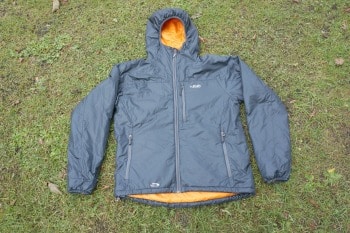
Best Use: Ski/Snowboard / Ice Climbing / Alpine Climbing / Hiking / Trekking
Average Weight: 12 oz
Sizes: S-XXL
Fit: Slim
Insulation: 60g/m2 PrimaLoft Gold Insulation Active
Shell: Pertex Quantum
Lining: 100% nylon Ripstop
Price: $157-$225
Description: This Rab Xenon X Hoodie – Men’s is made to fight the elements. In fact, it can serve as both the middle insulation layer and the outer shell wrapped in one jacket. The top layer of fabric is designed to be wind and water resistant.
While wind and water resistance is great for things coming at you, it also makes for a jacket that lacks breathability and doesn’t let any heat or moisture out. But don’t let this be a deterrent – it is a great, lightweight jacket that packs easily and has a lot of warming power.
It has a terrific collar that is fleece lined for an extra soft layer against your neck. There is a two-way zipper with storm baffle. The sleeves have stretchy cuffs and the waist has a drawstring for blocking out wind and weather.
There are two external hand warmer pockets and one inside pocket that doubles as the stuff sack. The jacket is easy to stow and clip on to your pack for easy accessibility. It comes in three colors.
The North Face ThermoBall Full Zip

Best Use: Alpine Climbing / Hiking / Trekking – any outdoor activity, really
Average Weight: 12.34 oz
Sizes: XS-XXL
Fit: Regular
Insulation: 15-Denier, 33 g ThermoBall™ powered by PrimaLoft® – 100% nylon insulation (this type is supposed to simulate down insulation)
Shell: 100% nylon
Lining: 100% nylon
Price: $100-$351
Description: The North Face is quilted in streamlined baffles to contour to your body and maintain warmth. The insulation has the ability to compress like down and warming power equivalent to 600 fill goose down.
This North Face ThermoBall Full Zip is perfect for a middle layer jacket to use alone at moderate temperatures and in layers for more extreme cold weather. The shell has been treated with a durable water repellant finish. There are two handwarmer pockets; one acts as the stow sack.
The sleeves have internal elastic cuffs and the waist has a cinch cord accessed through the hand pocket. This jacket boasts a lifetime warranty and is machine washable.
One shortcoming of this jacket is it does not have a hood, which means making sure you find other headgear to keep your cranium from freezing. This jacket comes in 17 colors.
Patagonia Nano Puff

Best Use: Casual Wear, Climbing, Cycling, Fishing, Hiking
Average Weight: 11.8 oz
Sizes: XS-XXL
Fit: Regular
Insulation: 60g PrimaLoft® Gold 100% polyester
Shell: 1.4-oz 22-Denier 100% recycled polyester
Lining: 1.4-oz 22-Denier 100% recycled polyester
Price: $150-$325
Description: Similar to the Patagonia Nano Air Hoody, the Nano Puff has sleek brick quilting to retain heat and offer great flexibility when moving. The polyester insulation has the stretching power to move in every direction. The shell has a durable water repellant finish to keep moisture out.
The zipper has a storm flap to add extra protection from the elements. There are two zippered handwarmer pockets and a zippered interior pocket to keep your valuables safe. There’s nothing worse than losing your keys in a snowbank on a mountaintop.
There is a draw cord around the waist. This jacket does not have a hood; so be on the lookout for something to keep your ears warm.
Black Diamond First Light Hoody

Best Use: Rock climbing, hiking, ski tours, and backcountry trekking
Average Weight: 18 oz
Sizes: S-XL
Fit: Regular
Insulation: 60g/m2 PrimaLoft Gold Insulation Active
Shell: Schoeller® stretch-woven nylon with NanoSphere® Technology
Lining: 100% Nylon woven mesh
Price: $200-$249
Description: This award winning Black Diamond First Light Hoody is designed to move with your body; the insulation has a stay-put power so it won’t bunch up. The unique insulation allows it to breathe during intense active workouts, yet keep you warm when you need it.
The shell’s NanoSphere® technology is designed to repel water, dirt, and oil. There are two zippered handwarmer pockets and an internal chest pocket that acts as a stuff sack with a carabiner loop to clip on your pack.
The hood on this jacket is designed to be helmet ready for those who like to scale rock walls in the height of winter. The waist has an adjustable drawstring and the sleeves have low profile elastic cuffs. This jacket is Bluesign® approved; meaning it was constructed with the environment in mind according to standards that are becoming more and more popular in the textile industry.
It means monitoring water input, air emissions, chemical use, in other words, its ecotoxicological (big word) impact.
Outdoor Research Men’s Cathode Hooded Jacket

Best Use: Great outdoor generalist
Average Weight: 13.4 oz
Sizes: S-XXL
Fit: Slim
Insulation: 60 g/m2 PrimaLoft® Gold 100% polyester insulation
Shell: Pertex® Quantum, 100% nylon 22-Denier Ripstop; Schoeller® 96% polyester, 4% spandex 50-Denier double weave underarm panels
Lining: Pertex® Quantum, 100% nylon 22-Denier Ripstop
Price: $148-$199
Description: The shell on this award winning Outdoor Research Men’s Cathode Hooded Jacket is water and wind resistant, yet breathable. It has a hybrid mapped construction with a sort of zigzag baffle pattern. The underarm panels are a soft shell made for movement, stretching and reaching.
The insulation is one of the best: PrimaLoft® Gold. The sleeves have elastic cuffs that will keep out the cold and a drawstring at the hem. There are two zippered handwarmer pockets. The zipper is one way and protected by an internal storm flap.
One doubles as a stuff sack. There is a zippered chest pocket as well. The hood is fully insulated and adjustable.
Outdoor Research Men’s Uberlayer Hooded Jacket

Best Use: Aerobic climbs, ski tours, and backcountry trekking
Average Weight: 19.9 oz
Sizes: S-XXL
Fit: Slim
Insulation: 98g/m2 Polartec® Alpha Insulation 100% polyester
Shell: 100% Nylon 30-Denier, stretch woven
Lining: 100% Polyester stretch mesh
Price: $209-$299
Description: This Outdoor Research Men’s Uberlayer Hooded Jacket checks off all the right boxes: water resistant, wind resistant, breathable, and lightweight. The 98g of insulation puts this jacket on the higher end of warmth compared to others in this list.
This jacket is also big on pockets. There are two handwarmer pockets and a chest pocket all with zippers. There are 2 internal pockets. The main zipper has an inside storm flap. The front zipper is also a double zip, so you can zip down from the top or up from the bottom at any time.
The hem of the jacket has a drawstring. The cuffs on the sleeves have a soft elastic cuff. You can buy this jacket in one of 11 fantastic colors.
Arc’teryx Atom LT Hoody
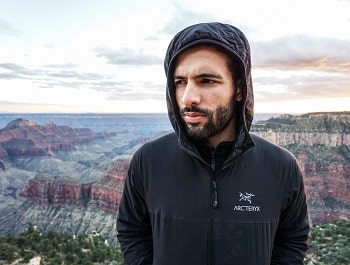
Best use: Ski/Snowboard / Ice Climbing / Alpine Climbing / Hiking / Trekking
Average Weight: 12.7 oz
Sizes: S-XXL
Fit: Slim
Insulation: Coreloft™ synthetic; Side panels and underarms feature Polartec® Power Stretch® with Hardface® Technology
Shell: Tyono™ 20-Denier with DWR treatment – 100% nylon
Lining: Taffeta
Price: $172-$995
Description: The Atom LT is easily compressed and stored in a pocket that doubles as a stuff sack. Pull it out, give it a shake and the loft is restored and the jacket is ready to go. The Coreloft insulation works with your body and does not bunch up inside the jacket.
It is extremely moisture, wind and cold resilient. The side panels and underarm sections have the Polartec insulation, which again is made for performance. The outer shell of the jacket is treated with durable water resistant to easily shed moisture. In fact, this jacket can dual as your top outer shell in light rain so you don’t need a heavier outer layer.
The hood is helmet compatible with dual adjustments. There are two hands warmer pockets and two internal pockets, all with zippers. The sleeves are finished over with rib knit cuffs. The waist has a drawstring. This jacket comes in 8 colors for men.
It’s A Wrap, Not to Be Confused with A Jacket
Eight stand out jackets that can wrap you in warmth. Great for the outdoorsman who pushes the limits: mountain climbs, ski tours, backcountry packing, snowboarding, etc. If it is outdoors and cold, any of these jackets could do the trick. Also, don’t forget that the jacket is not the only one that counts when you’re outside; you also need a great pair of boots. We have a great article on the best hiking boots with reviews and tips on how to choose the right pair for you.

Sometimes it comes down to personal preference: hood/no hood; soft shell/hard shell; grams of insulation; double open zipper or single; there are a lot of choices and features to choose from, including colors. There are some fabulous color choices – all will blend with a range of natural colors.
Don’t be the one who is left standing out in his field. Be the one who is wearing an outstanding jacket.



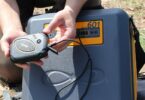
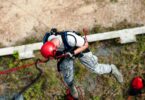
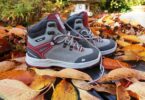
Insulated jackets are specifically made for mountaineers, hikers, and outdoor experts. It is suitable for early spring, late fall, and winter seasons when the weather seems to be too cold. There are some factors that can help you to make a buying decision like fabrics, linings, vents, pockets, sizes, and hoods. Can these jackets help you to stay warm and survive the in the wilderness?
Insulated jackets are the most recommended top wear when hiking, mountaineering, camping, or alpine climbing. They do not only keep you warm, but also waterproof in case you run into light showers.
Have you personally used the Arcteryx Men’s atom? I am looking to buy one for myself because it looks good, and the material looks comfortable and I hope it performs good as well because for its price I think it should be one of the better options when shopping for jackets.
I want to buy a Black Diamond light Hoodie because of your great writeup, it looks lightweight and enough to keep me warm when hiking. I also like that is is water and dirt resistant. I just want to ask you if the nanotech coating (waterproofing) will wash away with time or is it a permanent quality of the fabric?
The light and breathable insulation for alpine climbing, cold weather, and light showers is effect, but at some point the insulation may wear out. However, you can use waterproofing spray to reestablish the insulation.
Yes, I have a black Arc’teryx Atom LT Hoody; it has served me well for a while now. I like the fact that it is lightweight, and highly wind resistant. You should definitely buy this jacket.
One of the best I’ve ever tried was Sitka Kelvin lite down jacket, was extremely light and warm. Sadly I’ve torn it by accident and had to switch it out, was a great jacket though.